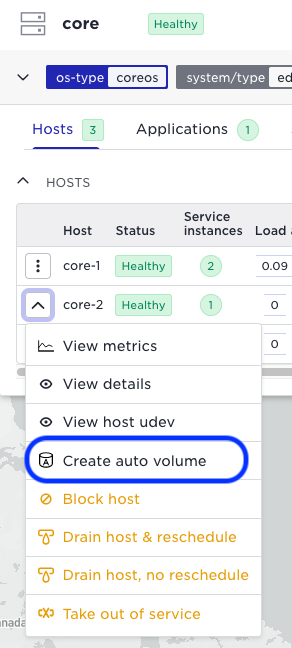Volume storage configuration
This page gives examples on how to set up a site to allow for different storage options. To see examples of configuring storage for an application see Applications.
For an overview on how host storage relates to application storage, see this fundamentals chapter.
Filesystems without quota support
It is perfectly fine to use filesystems without quota support for storing volumes. There are two drawbacks though:
- The Edge Enforcer cannot enforce maximum volume sizes
- Disk metrics will not be collected for volumes
Support container writable layer size limit
Limiting container layer size is implemented using filesystem project quota
feature. Container layers are stored by the docker daemon, typically under
/var/lib/docker/overlay2. Hence, in order for the size limit to be enforced,
this path must be located on a supported filesystem, such as:
- ext4 filesystem with
prjquotaflag enabled. - XFS filesystem with
d_typesupport andprjquotaflag enabled.
findmnt -T /var/lib/docker/overlay2
SOURCE TARGET FSTYPE OPTIONS
/var/lib/docker /dev/sda1 ext4 rw,relatime,prjquota
findmnt -T /var/lib/docker/overlay2
SOURCE TARGET FSTYPE OPTIONS
/var/lib/docker /dev/sda1 xfs rw,relatime,attr2,inode64,logbufs=8,logbsize=32k,prjquota
Allocating storage for application ephemeral and persistent volumes
Ephemeral and persistent application volumes are placed on host volumes called
local-volumes in the site configuration. If there are no host volumes
configured, then an application requesting an ephemeral or persistent volume
will fail to be scheduled.
- name: stockholm-sergel
type: edge
hosts:
- host-id: 94d4f410-1ef7-4f01-a296-c4ce4f23bf0e
local-volumes:
- name: local-disk-volume-storage
path: /local-volumes-storage
size: 1TB
labels:
type: ssd
- host-id: af909c45-47ce-4198-a38e-6ced4ec121f6
- host-id: 3cac9e07-8560-48ad-876f-db62d2258d6c
local-volumes:
- name: slow-storage
path: /slow
size: 100TB
labels:
type: hdd
All host volumes are located under a single path indicated by
$HOST_VOLUMES_DIR environment variable at system start time, the default
location is /var/lib/supd/volumes. Any filesystems already mounted outside
this location should be bind-mounted to a path under $HOST_VOLUMES_DIR. The
path indicated in line 7 and line 15 in the example above is relative to
$HOST_VOLUMES_DIR regardless of the leading path separator.
Different hosts in the site may provide different storage options. Applications may explicitly request certain storage or class of storage using a label expression with the labels configured by the site provider and communicated to the application creator. This is considered in scheduling decisions.
Development option: system-defined host volume
Allocating storage for application volumes requires coordination between someone
with administrative privileges in Avassa platform to create the local-volumes
configuration and someone who has privileges to access the filesystem and make
sure that the paths in the local-volumes configuration point to the desired
storage. In some cases, especially during the development phase, it may be
practical to provide the applications with some kind of storage without the
hassle of the coordination between different parties. In this case it is
motivated to use the system-defined auto volume.
In production environment it is recommended to keep the local volumes on a separate partition to prevent the applications managed by the Avassa solution from competing for disk storage with the OS or the Avassa platform. Therefore, the system-defined host volume is only suitable for development environments.
An auto volume is an implicit local-volumes definition which is inactive
by default. In order for it to be activated a filesystem path corresponding
to this definition must be created.
The Avassa platform defines the following action to create the filesystem path and activate the auto volume:
supctl do -s stockholm-sergel system cluster hosts stockholm-sergel-001 create-auto-volume
Or in the UI:

This action creates a directory _auto under /var/lib/supd/volumes and
activates the auto volume.
An alternative to running the action is to create a directory or a mountpoint
_auto under /var/lib/supd/volumes on the host manually before starting supd,
which is another way to activate the auto volume definition.
Verify that the auto volume is active on the host:
supctl show -s stockholm-sergel system cluster hosts stockholm-sergel-001 --fields local-volumes
local-volumes:
- name: auto
status: up
filesystem:
type: ext4
size-limit-support: false
is-mountpoint: false
space:
total: 232.83 GiB
allocated: 0 B
free: 232.83 GiB
Support for ephemeral and persistent volume size limit
Similarly to the container writable layer, the ephemeral or persistent volume size limit is implemented using filesystem quota. Hence the host volumes that should support enforceable application ephemeral or persistent volume size limit must be located on a supported filesystem with project quota flag enabled:
- ext4 filesystem with
prjquotaflag enabled. - XFS filesystem with
d_typesupport andprjquotaflag enabled.
findmnt -T /var/lib/supd/volumes/local-volumes-storage
SOURCE TARGET FSTYPE OPTIONS
/var/lib/supd/volumes/local-volumes-storage /dev/sda2 ext4 rw,relatime,prjquota
findmnt -T /var/lib/supd/volumes/slow-storage
SOURCE TARGET FSTYPE OPTIONS
/var/lib/supd/volumes/slow-storage /dev/sda2 xfs rw,relatime,attr2,inode64,logbufs=8,logbsize=32k,prjquota
The support for volume size limit can be confirmed by looking at
the show system cluster hosts output:
supctl show --site stockholm-sergel system cluster hosts
- cluster-hostname: stockholm-sergel-001
oper-status: up
host-id: 94d4f410-1ef7-4f01-a296-c4ce4f23bf0e
local-volumes:
- name: local-disk-volume-storage
status: up
filesystem:
type: ext4
size-limit-support: true
is-mountpoint: true
space:
total: 1.92 TiB
allocated: 952 GiB
free: 1.01 TiB
Add image with quota support
In case your filesystem doesn't have quota support, you can create an image file and mount that file with quota support.
This example will create a 20MB image file and mount that as a volume called xfs.
Create and format the /xfs.img image with xfs.
fallocate -l 20M /xfs.img
xfsdev=$(losetup -f --show /xfs.img)
mkfs.xfs $xfsdev
losetup -d $xfsdev
Add it to /etc/fstab to be mounted after host reboot
echo '/xfs.img /var/lib/supd/volumes/xfs xfs loop,prjquota 0 0' >> /etc/fstab
Mount it
mkdir -p /var/lib/supd/volumes/xfs
mount /var/lib/supd/volumes/xfs
This volume can now be configured as
- name: stockholm-sergel
type: edge
hosts:
- host-id: 94d4f410-1ef7-4f01-a296-c4ce4f23bf0e
local-volumes:
- name: xfs-with-quota
path: /xfs
size: 20MB